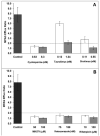Mycophenolic acid glucuronide is transported by multidrug resistance-associated protein 2 and this transport is not inhibited by cyclosporine, tacrolimus or sirolimus
- PMID: 22934787
- PMCID: PMC4116557
- DOI: 10.3109/00498254.2012.713531
Mycophenolic acid glucuronide is transported by multidrug resistance-associated protein 2 and this transport is not inhibited by cyclosporine, tacrolimus or sirolimus
Abstract
1. The purpose of this study was to investigate the contribution of MRP2 to the efflux of mycophenolic acid (MPA), and its phenyl glucuronide (MPAG) and acyl glucuronide (AcMPAG) metabolites, using Madin-Darby canine kidney II cells stably transfected with human MRP2 gene (MDCKII/MRP2 cells). 2. Compared to parental MDCKII cells, MPAG was significantly translocated from basolateral (BL) to apical (AP) side in MDCKII/MRP2 cells, indicating MPAG is a substrate for MRP2. AcMPAG is highly translocated from BL to AP side in both cells, suggesting that AcMPAG is actively secreted possibly through an efflux transporter other than MRP2. Appreciable translocation of MPA was not observed in MDCKII/MRP2 cells. 3. Furthermore, using MRP2-expressing Sf9 membrane vesicles, the Michaelis-Menten constant (Km) value for MRP2-mediated MPAG transport was calculated at 224.2 ± 42.7 µM. In the vesicle system, cyclosporine, tacrolimus and sirolimus did not inhibit the uptake of MPAG via MRP2. 4. These findings indicate that only MPAG not MPA and AcMPAG is a substrate for MRP2 and that the interaction between MPAG and concomitantly administered immunosuppressive agents does not occur at MRP2 level.
Conflict of interest statement
Figures



Comment in
-
The pharmacokinetic interaction between mycophenolic acid and cyclosporine revisited: a commentary on "Mycophenolic acid glucuronide is transported by multidrug resistance-associated protein 2 and this transport is not inhibited by cyclosporine, tacrolimus or sirolimus".Xenobiotica. 2013 Sep;43(9):836-8. doi: 10.3109/00498254.2012.761742. Epub 2013 Jan 23. Xenobiotica. 2013. PMID: 23339626 No abstract available.
References
-
- Chen C, Slitt AL, Dieter MZ, Tanaka Y, Scheffer GL, Klaassen CD. Up-regulation of Mrp4 expression in kidney of Mrp2-deficient TR- rats. Biochem Pharmacol. 2005;70:1088–95. - PubMed
-
- Chen J, Terada T, Ogasawara K, Katsura T, Inui K. Adaptive responses of renal organic anion transporter 3 (OAT3) during cholestasis. Am J Physiol Renal Physiol. 2008;295:F247–52. - PubMed
-
- Davies NM, Grinyo J, Heading R, Maes B, Meier-Kriesche HU, Oellerich M. Gastrointestinal side effects of mycophenolic acid in renal transplant patients: a reappraisal. Nephrol Dial Transplant. 2007;22:2440–8. - PubMed
-
- Evers R, Kool M, van Deemter L, Janssen H, Calafat J, Oomen LC, Paulusma CC, Oude Elferink RP, Baas F, Schinkel AH, Borst P. Drug export activity of the human canalicular multispecific organic anion transporter in polarized kidney MDCK cells expressing cMOAT (MRP2) cDNA. J Clin Invest. 1998;101:1310–9. - PMC - PubMed
-
- Giacomini KM, Huang SM, Tweedie DJ, Benet LZ, Brouwer KL, Chu X, Dahlin A, Evers R, Fischer V, Hillgren KM, Hoffmaster KA, Ishikawa T, Keppler D, Kim RB, Lee CA, Niemi M, Polli JW, Sugiyama Y, Swaan PW, Ware JA, Wright SH, Yee SW, Zamek-Gliszczynski MJ, Zhang L. Membrane transporters in drug development. Nat Rev Drug Discov. 2010;9:215–36. - PMC - PubMed
Publication types
MeSH terms
Substances
Grants and funding
LinkOut - more resources
Full Text Sources
